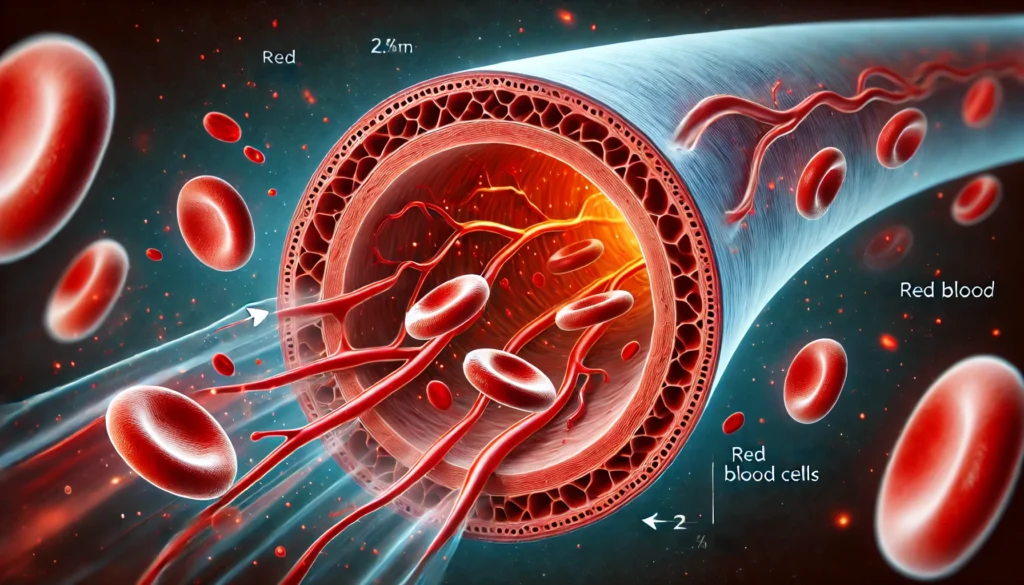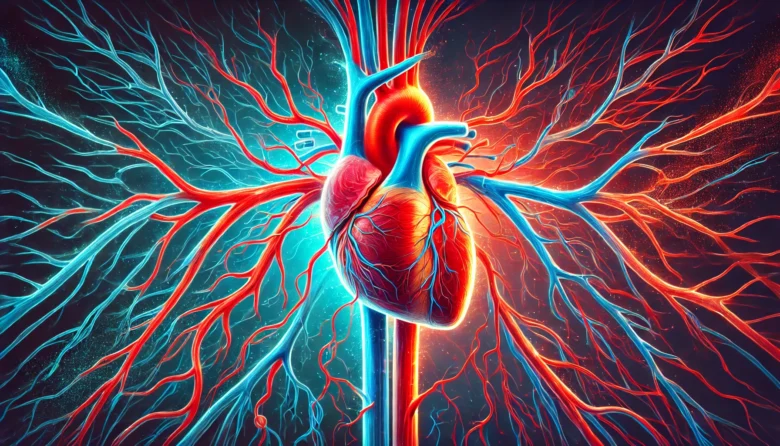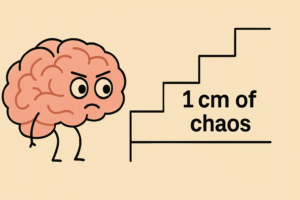Ever wondered what keeps you alive every single second of your life? It’s not just the food you eat or the air you breathe; it’s your blood, constantly circulating throughout your body. But there’s more to it than just pumping blood. The physics of blood circulation plays a critical role in making sure every cell in your body gets the oxygen and nutrients it needs. In this blog, we’ll explore the fascinating mechanics of blood circulation and how the principles of physics keep your heart pumping and your blood flowing smoothly.
The Role of Pressure in Blood Circulation
Blood circulation starts with the heart, the engine that keeps everything moving. When the heart beats, it generates pressure. This pressure creates a force that pushes blood through your arteries, veins, and capillaries. This is known as hemodynamics (the study of blood flow).
Blood moves from areas of high pressure to areas of low pressure. The highest pressure is in the arteries right after the heart pumps, while the lowest is in the veins as blood returns to the heart. This pressure gradient is what drives the flow of blood through your body. Think of it like a garden hose: when you increase the water pressure, the water flows faster. Similarly, the higher the pressure difference in your body, the faster blood flows.
Blood Viscosity and Resistance
Blood is not as simple as water—it’s a complex mixture of plasma, red blood cells, white blood cells, and platelets. This mixture gives blood a certain viscosity (a measure of a fluid’s resistance to flow). The thicker or more viscous the blood, the more resistance it faces as it travels through blood vessels.
For example, imagine stirring honey versus stirring water. Honey, being thicker, requires more effort to move. Similarly, when your blood viscosity is high, your heart has to work harder to pump it. This is why health conditions like dehydration or an excess of red blood cells (polycythemia) can strain the heart and affect circulation.
The body has mechanisms to maintain an optimal balance. When blood vessels constrict (become narrower), it increases resistance, which in turn increases blood pressure to ensure blood can still reach distant organs. When they dilate (widen), resistance decreases, allowing for more effortless blood flow.

The Importance of Vessel Diameter: Poiseuille’s Law
Blood vessels come in different sizes, from the large aorta to tiny capillaries. The size or diameter of these vessels dramatically affects how easily blood can flow through them. This is explained by Poiseuille’s Law, which states that the flow rate of a fluid (like blood) through a vessel is directly proportional to the fourth power of the vessel’s radius.
In simpler terms, if the radius of a blood vessel doubles, the blood flow through it increases by a factor of 16! This is why even slight constrictions or dilations of blood vessels can have a significant impact on your circulation.
For example, during exercise, your body releases signals that cause your blood vessels to dilate, especially in the muscles being used. This increases blood flow, ensuring that those muscles get the oxygen and nutrients they need to keep you going.
Turbulence vs. Laminar Flow
Blood flow in the body can either be laminar (smooth and orderly) or turbulent (chaotic). Most of the time, blood flow is laminar, meaning it moves in parallel layers with minimal mixing. This is ideal because it allows blood to flow more efficiently.
However, under certain conditions—such as when blood flows through narrowed or damaged arteries—blood can become turbulent. Turbulent flow creates swirling patterns that increase resistance and make the heart work harder to push blood through. It’s also a warning sign of potential cardiovascular problems, such as atherosclerosis (the buildup of fatty deposits in arteries).
Doctors can sometimes detect turbulence by listening to the sound of blood flow through a stethoscope. Turbulent flow makes a distinctive sound, often described as a “bruit,” which could indicate a narrowing of blood vessels.
The Heart as a Pump: Bernoulli’s Principle
The heart works like a pump, using pressure to propel blood. But this isn’t just any pump; it operates based on Bernoulli’s Principle, which relates to the conservation of energy in fluid dynamics. According to Bernoulli’s Principle, when the velocity of a fluid (in this case, blood) increases, its pressure decreases.
When your heart pumps, it increases the velocity of the blood entering the aorta. As blood velocity increases, the pressure in the arteries decreases, allowing blood to be distributed more evenly to different parts of the body. This principle ensures that even organs far from the heart, like your toes, get adequate blood flow without the heart having to exert excessive force.
Gravity and Blood Circulation
One of the most fascinating aspects of blood circulation is how it works against gravity. When you’re standing up, gravity pulls blood down toward your legs and feet. So, how does blood make it back to your heart?
This is where your veins and the concept of hydrostatic pressure come into play. Veins contain one-way valves that stop blood from flowing in the wrong direction. Additionally, your leg muscles act as pumps, squeezing the veins and pushing blood upward when you walk or move.
If you’ve ever noticed your legs swelling after sitting or standing for long periods, it’s because your blood isn’t being pumped effectively against gravity. This condition, called venous pooling, is usually temporary and can be relieved by walking or elevating your legs.
Case Study: The G-Force Challenge for Fighter Pilots
Here’s an interesting application of the physics of blood circulation: fighter pilots experience extreme gravitational forces (G-forces) during high-speed maneuvers. Under these conditions, blood is forced downward, away from the brain, which can cause pilots to black out—a condition known as G-induced Loss of Consciousness (G-LOC).
To combat this, fighter pilots wear special G-suits that squeeze their legs and abdomen, increasing blood pressure and helping to keep blood circulating to the brain. This is a perfect example of how understanding the physics of blood circulation can be applied in real-world situations to save lives.
Conclusion
The physics of blood circulation is a complex and dynamic system that keeps us alive, day in and day out. From the pressure exerted by the heart to the effects of gravity and the mechanics of blood vessels, each aspect plays a crucial role in ensuring that every part of your body gets the blood it needs. Understanding these principles not only helps us appreciate the wonders of the human body but also opens the door to advancements in medicine and technology. Next time you feel your heart race after climbing a flight of stairs or doing exercise, you’ll know it’s physics at work!
Author’s Note
The journey of exploring how physics intersects with biology in such intricate ways is endlessly fascinating. I hope this blog sparks your curiosity about how science governs even the most ordinary actions in our lives.
G.C., Ecosociosphere contributor.
References and Further Reading
- Harvard Medical School: The Physics of Blood Flow
- The Role of Viscosity in Blood Flow
- function of the arterial blood in circulating blood – Tech Solar. https://www.nodewin.my.id/2023/05/function-of-arterial-blood-in.html





Comments
Currently it seems like BlogEngine is the preferred blogging platform out there right now. (from what I’ve read) Is that what you are using on your blog?
I wanted to compose a simple word to appreciate you for all the magnificent tips and tricks you are showing here. My considerable internet lookup has at the end of the day been recognized with beneficial points to talk about with my friends. I would say that most of us site visitors are truly fortunate to live in a perfect community with very many wonderful people with very helpful tips. I feel very grateful to have come across your site and look forward to so many more amazing times reading here. Thanks a lot once more for all the details.
I am really impressed along with your writing skills as neatly as with the format on your weblog. Is this a paid topic or did you modify it yourself? Either way stay up the excellent quality writing, it抯 rare to peer a nice blog like this one nowadays..
The articles you write help me a lot and I like the topic
May I have information on the topic of your article? http://www.hairstylesvip.com
naturally like your website however you have to test the spelling on quite a few of your posts.
Several of them are rife with spelling issues and
I find it very bothersome to inform the reality then again I
will definitely come again again.
That is really interesting, You are an overly skilled blogger.
I have joined your rss feed and sit up for in quest of more of your fantastic post.
Additionally, I have shared your site in my social networks
Also visit my web site: nordvpn coupons inspiresensation
Generally I don’t learn article on blogs, but I would like to say that this write-up very compelled me to try and do so! Your writing style has been surprised me. Thanks, quite great article.
Thanks for the sensible critique. Me and my neighbor were just preparing to do a little research about this. We got a grab a book from our area library but I think I learned more from this post. I’m very glad to see such excellent info being shared freely out there.
Appreciate it for sharing the information with us.